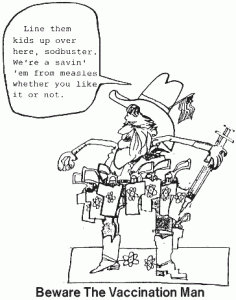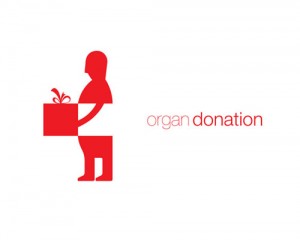The concept of childhood immunizations may seem exhausted to us now, given the number of discussions we’ve held on the subject. However, I find that Isaacs, Kilham and Marshall, in their paper Should Routine Childhood Immunizations be Compulsory?, do an excellent job of wholly representing convincing arguments for both sides as well as bringing up a few aspects of the debate that we have yet to discuss.
One subject that we have touched on briefly in class, the risk of injury from the vaccination versus the risk of injury if not vaccinated, is again mentioned here, but this time more in depth. Isaacs et al. provide actual numbers. For example, the routine measles vaccination “causes acute encephalitis with an incidence of one in a million doses” where as the risk of acute encephalitis if the person was to naturally be infected with measles, or the “wild-type infection”, is one in a thousand (399). This is a huge difference. I think it’s very important for this kind of comparative information to be presented to parents and the general public as part of an educational effort. If these are the crude facts, why do parents (assuming that they have this information) still say no to vaccinations? Isaacs et al. offers psychological reasoning that there is a tendency for parents to be more afraid of causing harm to their children because of something they actively did than because of something they didn’t do. “This is referred to as the fear of commission rather than of omission” (400). I think this is a very salient concept that is important for doctors to be aware of when discussing immunization with parents. In a moving quote from Benjamin Franklin, after the death of his son to smallpox after having not vaccinated him, Franklin proposes that regret is the same either way, and so the safer route (immunization) should be chosen (400).
Another topic we have discussed in regards to immunizations is the concept of free-riders and herd immunity. Once again, Isaacs et al. provides very vital information on the subject. Free-riders are those who opt out of immunizations under the impression that enough of the population will have gotten the vaccination that they will be protected from infection without needing to vaccinate themselves or their child. The issue that we haven’t discussed yet, however, is that there are known, calculated disease-specific percentages of the percentage of the population that needs to have been immunized for herd immunity to work. Going back to the example of measles, it is known that 95% of the population has to have received the measles immunization to ensure that no outbreaks will occur (401). For Hib disease, the percentage is slightly lower at 85%, but this only guarantees that rates will begin to rapidly decline (401). These percentages are an excellent tool for doctors to be equipped with when interacting with a “free-rider” parent. The doctor can then confidently tell them whether or not there is currently a sufficient amount of people immunized for their plan to work. Certainly though, there will be doctors who won’t care that these percentages have been reached and will still push for the parent to immunize, as I think the doctor should. But then the ethical question arises of whether the doctor is in the right to do so if the vaccination may not actually be necessary. Ethics would most likely find that at that point, the parent is ok not to vaccinate.
One last issue that I think Isaacs et al. did well to bring up is the idea of inducements instead of punishments to encourage child immunization. There has historically been, and currently been talk of, jail time as a punishment for refusing to immunize your child because you are not acting in the best interest of the child. However, putting the parent in jail certainly would not be in the best interest of the child, so realistically that is not an option. However, they offer the suggestion of child care benefit payments or maternity benefit payments to encourage parents to immunize their children. They also mention those families who rely on welfare. I think it is not only a great idea, but arguable as well. Why not require all children who receive Medicaid to be immunized? Isaacs et al. offer this idea, saying “if society provides child and family payments, it is reasonable for society to expect and even demand that children be immunized to help protect the whole community” (404).
Isaacs, Kilham, and Marshall. “Should Routine Childhood Immunizations be Compulsory? Holland, Stephen. Arguing About Bioethics. 398-406.



